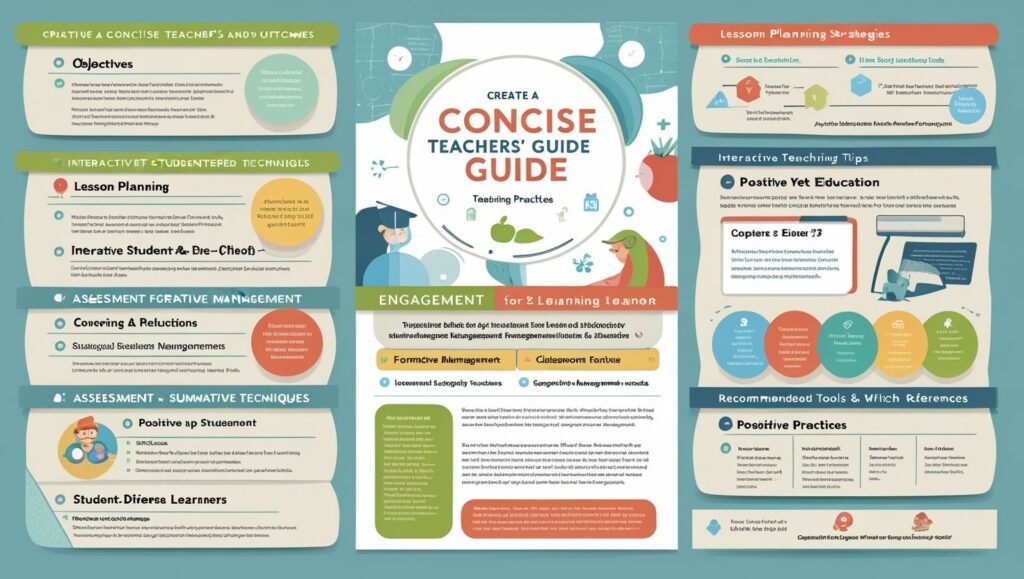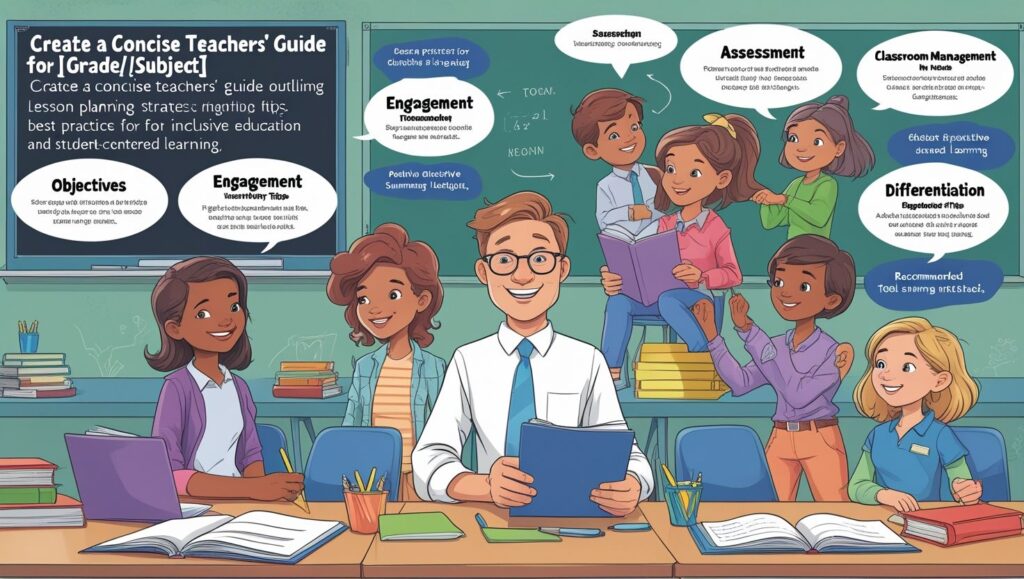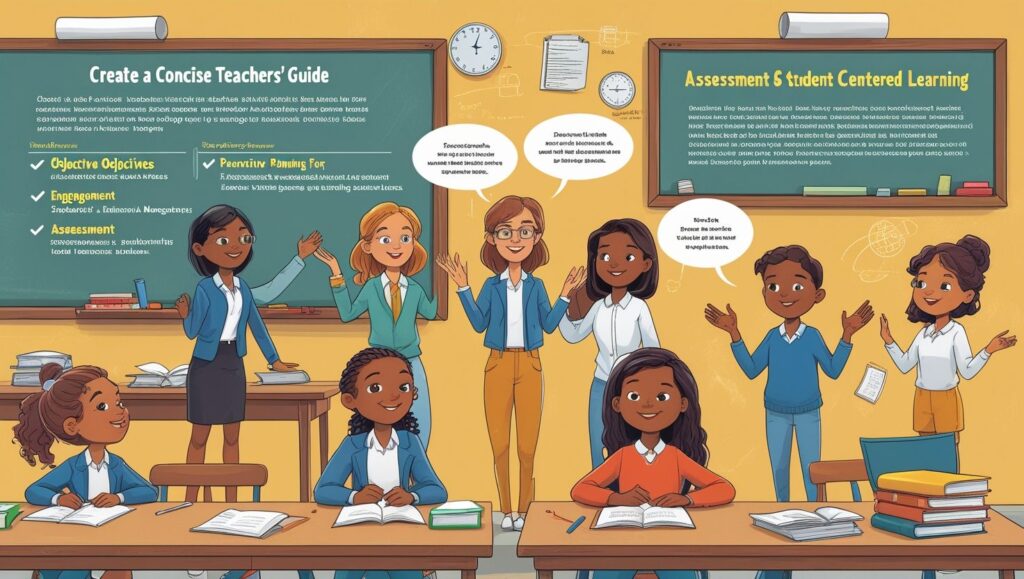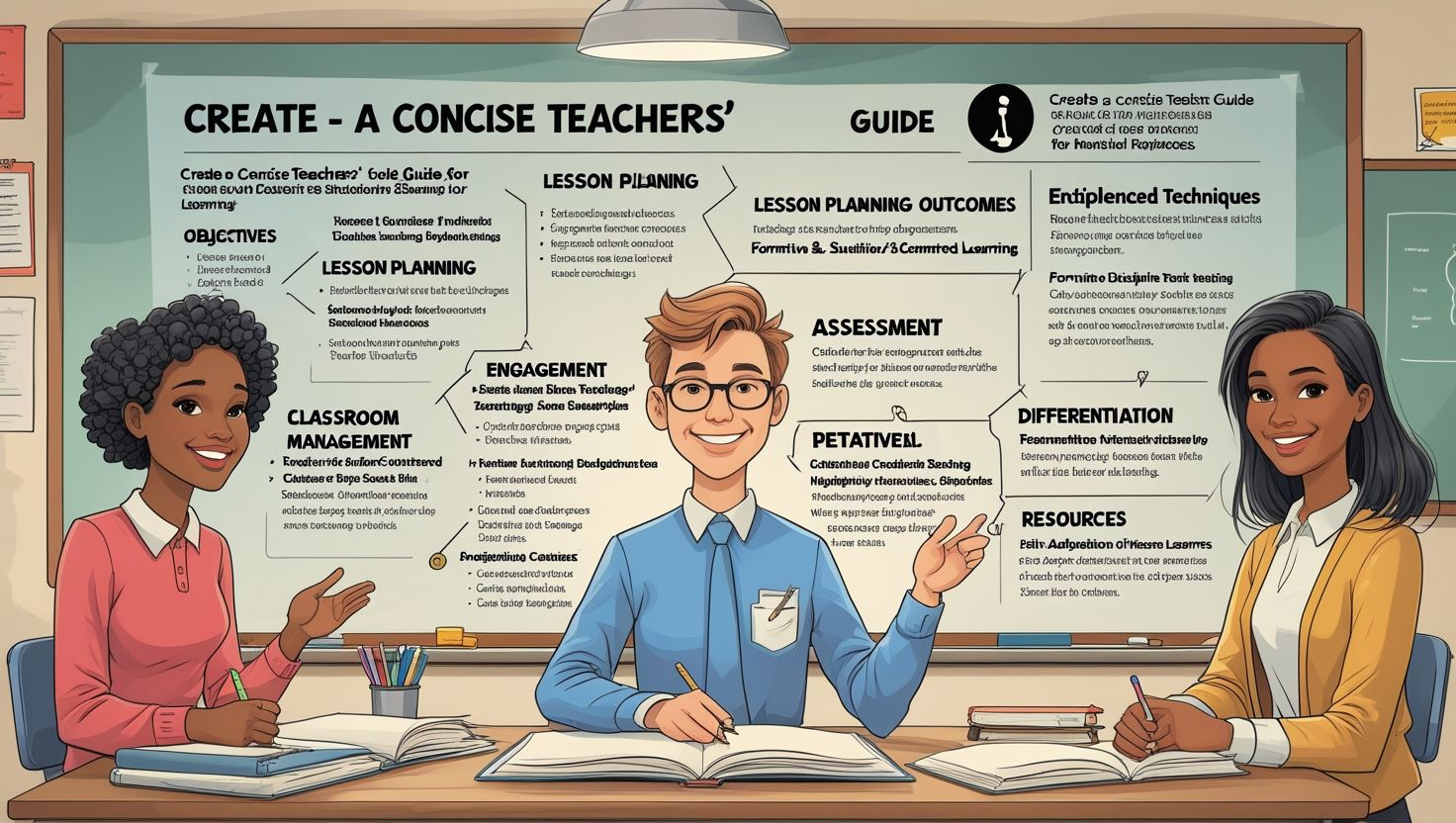1. Introduction to the Role of Teachers in Education
Teachers’ Guide in Education, Teachers are the cornerstone of any education system. They not only deliver content but also inspire, guide, and shape students’ values. A teacher’s guide in education is more than a manual—it’s a comprehensive approach to nurturing young minds. With the evolving needs of society and the rapid technological shifts, the role of teachers has grown beyond just academics. They serve as mentors, counselors, and facilitators of critical thinking. In today’s classrooms, the emphasis is on student-centered learning, and teachers must adapt to varied learning styles.
The teacher’s guide acts as a blueprint, helping them manage curriculum goals while attending to individual student needs. It offers strategies, objectives, and assessment tools tailored to ensure effective learning. As education becomes more inclusive and diverse, the teacher’s guide also includes approaches to handle multicultural classrooms, students with learning differences, and socio-emotional challenges. In essence, it’s a map that supports teachers in their journey of cultivating lifelong learners and responsible global citizens.
2. Curriculum Planning and Implementation
Effective curriculum planning is the backbone of quality education. A teacher’s guide in this area assists educators in aligning lesson plans with learning objectives, ensuring students grasp key concepts. This guide outlines the year’s academic goals, dividing them into weekly or monthly milestones. It includes scope and sequence charts that allow teachers to pace their teaching efficiently. Moreover, it provides tools for integrating various subjects, encouraging interdisciplinary learning.
A good curriculum guide also suggests resources like textbooks, online tools, and practical activities to enhance classroom engagement. Teachers use these tools to modify content according to students’ abilities, ensuring no one is left behind. Assessment rubrics, formative checks, and summative evaluations also included to track student progress effectively. Teachers can adapt these strategies to meet state or national education standards. Thus, curriculum planning through a teacher’s guide offers a structured and flexible framework that promotes consistency, creativity, and academic excellence in the classroom.

3. Lesson Planning Strategies
Lesson planning is a critical aspect of effective teaching. A well-structured teacher’s guide offers strategies to design daily lessons that align with curriculum goals while addressing students’ interests and learning styles. It begins by identifying learning outcomes, followed by selecting appropriate instructional methods, materials, and assessment tools. The guide emphasizes a clear lesson structure—starting with an engaging introduction, followed by content delivery, guided practice, and independent work. It suggests incorporating a variety of teaching methods like storytelling, inquiry-based learning, group work, and hands-on activities to maintain student engagement.
Additionally, it provides templates for differentiated instruction, ensuring that learners of all abilities can access and understand the content. Teachers encouraged to include time estimates, required resources, and potential challenges for each lesson. Reflection components at the end of each plan help educators evaluate what worked and what needs improvement. Thus, lesson planning strategies in a teacher’s guide empower educators to deliver meaningful, well-paced, and student-centered lessons consistently.
4. Classroom Management Techniques
Effective classroom management is vital for a conducive learning environment. The teacher’s guide offers tested strategies for maintaining discipline, fostering respect, and encouraging student participation. It emphasizes the importance of setting clear expectations from the start, including classroom rules and routines. Teachers are advised to consistent, fair, and proactive in handling behavioral issues. The guide includes techniques like positive reinforcement, peer mediation, and conflict resolution to promote a peaceful learning space.
It also recommends classroom layouts that enhance supervision and interaction, as well as seating arrangements that support collaborative learning. Managing transitions smoothly, using visual and verbal cues, and maintaining a calm demeanor essential practices outlined in the guide. For diverse classrooms, cultural sensitivity and inclusive practices are emphasized. Importantly, the guide advocates building strong teacher-student relationships based on mutual respect and understanding. By following these classroom management techniques, teachers can create an atmosphere where students feel safe, respected, and motivated to learn.
5. Assessment and Evaluation Tools
Assessment is not just about grading—it’s about understanding student progress and guiding instruction. A teacher’s guide includes a variety of assessment tools to measure learning outcomes accurately. These range from formative assessments like quizzes, class discussions, and observations to summative assessments such as tests, projects, and presentations. The guide helps teachers align assessments with learning objectives, ensuring they measure what students are expected to learn. Rubrics, checklists, and scoring guides are provided to maintain consistency and objectivity in grading.
The guide also encourages the use of self-assessments and peer evaluations to promote student reflection and responsibility. For students with diverse needs, the guide suggests accommodations and modifications that ensure fairness. It emphasizes the importance of feedback—clear, constructive, and timely—to help students improve. Furthermore, data from assessments can guide future lesson planning, helping teachers identify areas that need reteaching or extension. Overall, assessment and evaluation tools in the teacher’s guide ensure informed instruction and support continuous learning.

6. Incorporating Technology in Education
The integration of technology into teaching has transformed traditional classrooms into dynamic learning environments. A modern teacher’s guide includes methods for effectively incorporating digital tools to enhance instruction and student engagement. From interactive whiteboards and educational apps to virtual classrooms and online assessments, technology enables personalized learning experiences. The guide helps teachers select appropriate platforms based on curriculum goals and student proficiency. It provides strategies for flipping classrooms, using multimedia to explain concepts, and fostering collaboration through digital forums.
Teachers are also guided on managing screen time, promoting digital literacy, and addressing cybersecurity concerns. Importantly, the guide offers troubleshooting advice and tech support tips to ensure smooth lesson delivery. It emphasizes using technology not as a replacement for teaching but as a complementary tool that enhances comprehension and creativity. As digital natives dominate today’s classrooms, understanding how to navigate and integrate tech effectively is essential for teachers. A well-rounded guide ensures they remain competent and confident in this evolving educational landscape.
7. Fostering Inclusive Education
Inclusive education is about ensuring that all students, regardless of background or ability, have equal access to learning opportunities. A teacher’s guide dedicated to inclusion offers practical strategies to accommodate diverse learners in a mainstream classroom. It begins by promoting an inclusive mindset—valuing diversity and recognizing every student’s potential. The guide provides differentiation techniques such as varying content, process, and assessments to meet individual needs.
It offers tools for modifying curriculum for students with disabilities, including visual aids, assistive technology, and simplified instructions. Teachers are also encouraged to use universal design for learning (UDL) principles to create flexible learning environments. Cultural inclusivity addressed through the integration of multicultural content and culturally responsive teaching. The guide includes collaboration strategies with special education staff, families, and support services to implement individualized education plans (IEPs) effectively. Through these inclusive practices, teachers foster a classroom where every student feels respected, supported, and empowered to succeed academically and socially.
8. Developing Critical Thinking Skills
A key aim of modern education is to nurture critical thinkers—students who can analyze, evaluate, and solve problems independently. A teacher’s guide supports this goal by offering strategies to integrate critical thinking into everyday instruction. It encourages the use of open-ended questions, case studies, debates, and problem-based learning to challenge students’ assumptions and stimulate analysis. Teachers are guided on how to model critical thinking by verbalizing their thought processes during lessons.
The guide also provides frameworks such as Bloom’s Taxonomy and Socratic questioning to structure higher-order thinking activities. Encouraging students to justify their answers, consider alternative perspectives, and reflect on their reasoning are key components. Classroom discussions, peer reviews, and journal writing are used as platforms to develop these skills. Importantly, the guide suggests ways to assess critical thinking through projects, essays, and performance tasks. By embedding critical thinking into curriculum and instruction, teachers prepare students not only for exams but for lifelong decision-making and learning.
9. Student Engagement Strategies
Keeping students actively engaged is crucial for effective learning. A teacher’s guide includes a wide range of techniques to capture and sustain student interest throughout the lesson. It begins with understanding student interests and incorporating them into the content. Strategies include the use of storytelling, gamification, real-world connections, and project-based learning. The guide encourages interactive teaching methods such as group discussions, role-plays, and hands-on experiments. Visual aids, multimedia, and movement breaks are used to maintain energy and focus.
Teachers are also guided on using formative assessments like exit tickets and classroom polls to monitor engagement and adjust instruction accordingly. Building rapport and creating a supportive classroom environment emphasized as foundational to student participation. The guide advises varying teaching styles and activities to accommodate different attention spans and learning preferences. With consistent use of these engagement strategies, teachers can create vibrant classrooms where students are not just passive listeners but active participants in their learning journey.
10. Professional Development and Lifelong Learning
For teachers to remain effective and motivated, continuous professional development is essential. A teacher’s guide includes pathways for lifelong learning, offering resources and strategies to help educators grow in their practice. It highlights the importance of attending workshops, pursuing certifications, and engaging in collaborative learning communities. The guide also suggests reflective practices such as journaling, peer observations, and teaching portfolios to enhance self-awareness and improvement.
Staying updated with the latest educational research and trends is encouraged, as it enables teachers to adapt to new methodologies and technologies. The guide provides tips for time management and setting achievable professional goals. It also emphasizes self-care and work-life balance, recognizing that teacher well-being directly impacts student success. By promoting a growth mindset, the teacher’s guide motivates educators to view challenges as opportunities for development. In essence, it fosters a culture of continuous learning, ensuring teachers remain dynamic, informed, and passionate throughout their careers.
11. Building Teacher-Student Relationships
Strong teacher-student relationships are the foundation of an effective learning environment. A teacher’s guide emphasizes the importance of trust, empathy, and mutual respect in cultivating meaningful connections with students. These relationships create a sense of safety and belonging that encourages student participation and risk-taking. The guide outlines strategies such as active listening, personalized feedback, and consistent communication to strengthen rapport. It also highlights the importance of learning students’ names, interests, and cultural backgrounds to foster inclusivity and respect.
Simple actions like greeting students at the door, celebrating their achievements, and showing interest in their lives outside of academics go a long way in building bonds. Teachers are encouraged to maintain clear, respectful boundaries while still being approachable and supportive. Strong relationships also lead to better classroom management, as students are more likely to respect and cooperate with teachers they feel connected to. Ultimately, when students feel seen, heard, and valued, they become more motivated and engaged, which directly contributes to their academic and personal success.

12. Parental Involvement and Communication
Parental involvement plays a vital role in a child’s educational success. A teacher’s guide offers effective strategies for fostering strong home-school connections that support student learning. It begins by emphasizing the importance of regular and open communication with families. Teachers are encouraged to initiate contact early in the school year through welcome letters or introductory phone calls. The guide outlines tools such as newsletters, emails, parent-teacher conferences, and digital platforms like ClassDojo or Remind to keep families informed and engaged.
It also includes tips for addressing language barriers and scheduling challenges, ensuring all parents can participate regardless of their circumstances. Teachers learn how to provide constructive feedback and collaborate with parents to set goals and monitor progress. The guide stresses the importance of cultural sensitivity and respecting diverse family structures and values. When parents are involved, students feel supported both at home and at school, which boosts motivation, behavior, and academic performance. A strong partnership with families enhances the overall learning experience and contributes to student success.
13. Promoting Socio-Emotional Learning (SEL)
Socio-emotional learning (SEL) equips students with skills to manage emotions, build relationships, and make responsible decisions. A teacher’s guide includes SEL strategies as an essential component of holistic education. It helps educators integrate SEL into daily lessons and classroom routines. Core competencies such as self-awareness, self-management, social awareness, relationship skills, and responsible decision-making highlighted. The guide suggests activities like morning meetings, journaling, peer discussions, and mindfulness exercises to foster emotional well-being. Teachers are encouraged to model empathy, active listening, and conflict resolution to create a supportive environment.
The guide also includes frameworks like CASEL to align SEL instruction with best practices. Assessment tools for monitoring students’ social and emotional development are provided, including student self-reflection and teacher observations. Special attention is given to trauma-informed teaching practices and supporting students experiencing emotional distress. By prioritizing SEL, teachers nurture emotionally resilient students who better equipped to navigate academic and personal challenges, leading to improved behavior, collaboration, and academic performance.
14. Ethics and Professional Conduct
Upholding ethical standards and professional conduct is fundamental for educators. A teacher’s guide outlines these responsibilities to help teachers maintain integrity, accountability, and trust within the school community. Teachers are expected to demonstrate fairness, respect, and confidentiality in all interactions. The guide provides scenarios and case studies to help navigate ethical dilemmas related to grading, favoritism, student privacy, and professional boundaries. It emphasizes the importance of adhering to school policies, reporting misconduct, and maintaining objectivity in assessments and relationships.
Teachers are also guided on using digital platforms responsibly, ensuring appropriate communication and use of student data. Professional conduct includes punctuality, preparedness, and respectful collaboration with colleagues, administrators, and parents. The guide promotes continuous self-reflection and encourages teachers to seek feedback and mentorship. Maintaining professionalism fosters a safe and respectful learning environment and serves as a model for students. Ethical teachers not only build credibility but also play a crucial role in shaping responsible, principled future citizens through their example.
15. Addressing Learning Gaps and Remedial Teaching
Identifying and addressing learning gaps is a crucial part of effective teaching. A teacher’s guide provides actionable strategies for diagnosing and remediating academic deficiencies to ensure all students meet learning standards. Teachers are trained to use diagnostic assessments and formative evaluations to identify areas where students struggle. The guide outlines how to analyze this data and group students based on their specific needs. Remedial instruction techniques include re-teaching concepts using simplified language, visual aids, and hands-on activities.
Teachers are encouraged to slow the pace, break tasks into manageable steps, and provide frequent feedback and encouragement. The guide also highlights the importance of setting realistic goals and celebrating progress to boost student confidence. In addition, it emphasizes collaboration with support staff, such as special educators or reading specialists, to create effective intervention plans. By proactively addressing learning gaps, teachers ensure that no student is left behind and that each learner receives the support necessary to succeed and reach their full potential.
16. Creating a Positive Learning Environment
A positive learning environment is essential for academic success and student well-being. A teacher’s guide outlines how to cultivate a space that promotes respect, cooperation, and active participation. It starts with setting clear expectations and modeling positive behavior. Teachers are encouraged to create a welcoming atmosphere through inclusive language, culturally relevant materials, and classroom decor that reflects diversity. The guide emphasizes building a community through team-building activities, student voice opportunities, and class meetings.
Strategies for recognizing student efforts, using praise effectively, and establishing consistent routines are included. Teachers also learn to identify and address bullying, exclusion, or conflict promptly to maintain a safe space. Emotional safety is fostered through empathy, patience, and encouragement. The guide recommends flexible seating, calming corners, and brain breaks to support focus and comfort. A positive environment reduces anxiety, boosts motivation, and encourages risk-taking in learning. When students feel supported and valued, they are more likely to engage, collaborate, and achieve their academic goals confidently.
17. Conclusion:
The role of the teacher is dynamic and ever-evolving in response to changes in society, technology, and student needs. A teacher’s guide reflects this evolution by offering a comprehensive framework for effective teaching that balances academic instruction, emotional support, and ethical practice. Teachers today are not just instructors; they are facilitators, mentors, counselors, and lifelong learners. They must adapt to diverse classrooms, leverage digital tools, and foster critical, creative thinking.
The guide serves as a roadmap, providing clarity, structure, and flexibility as educators navigate the complexities of modern education. It supports teachers in fostering inclusive, engaging, and safe environments where students can thrive. Moreover, it underscores the importance of reflection, professional growth, and continuous improvement. As education continues to change, so too must the strategies and supports provided to teachers. The teacher’s guide is more than a manual—it is a testament to the professionalism, dedication, and impact that educators bring to the lives of their students every day.

kırmadan dökmeden su kaçak tespiti Boru korozyonu, eski binalarda su kaçağının yaygın bir nedenidir. https://helpdesk.rikor.com/uskudar-tesisatci-tikaniklik-acma/
Kadıköy su kaçağı tespiti Beşiktaş Kuruçeşme’deki su kaçağını doğru tespit ettiler. Gerçekten harika bir ekip! https://www.radioavang.org/?p=71908
Fatih su kaçak tespiti Salon zeminindeki su kaçağını termal kamerayla buldular. Parkeleri koruyarak sorunu çözdüler. Hande H. http://ruffeodrive.com/?p=34460
ОФИЦИАЛЬНАЯ ССЫЛКА на всеми любимый сайт:
https://kro33.cc
Это самая ПОСЛЕДНЯЯ ОФИЦИАЛЬНАЯ ссылка.
Кракен давно зарекомендовал себя как качественный сервис на территории всего постсоветского простраинства и не только, но даже у таких очевидных плюсов, бывают неочевидные минусы, такие как мошенники, которые подделывают официальную ссылку.
Даркнет: Всё, что нужно знать о Кракен ссылке, сайте и доступе через Tor
Кракен Вход Clear-net(Обычный браузер)
https://kro33.cc
Пользуйтесь только самой актуальной ссылкой!
Преимущества использования Кракен Даркнет
Почему пользователи выбирают Кракен сайт среди других даркнет-платформ?
Безопасность: Платформа обеспечивает высокий уровень защиты данных пользователей.
Анонимность: Все транзакции проходят через сеть Tor, что исключает возможность отслеживания.
Вход наКракен Даркнет может быть безопасным и удобным, если вы используете проверенные Кракен ссылки и следуете всем рекомендациям. Для получения доступа убедитесь, что используете только надёжные источники и избегаете фишинговых сайтов.
Следуя нашим инструкциям, вы сможете найти рабочую ссылку на Кракен сайт и воспользоваться всеми возможностями платформы без риска для себя.
САМАЯ ПОСЛЕДНЯЯ ссылка для доступа к КРАКЕНУ – https://kro33.cc
Ключевые слова: Кракен Даркнет, Кракен ссылка, Кракен сайт, Кракен Онион, Кракен чистая ССЫЛКА, Кракен доступе, КРАКЕН, KRAKEN,KRO, KRO33
кракен сайт
кракен официальный сайт
кракен сайт магазин
ссылка на сайт кракен
кракен сайт даркнет
кракен зеркало сайта
сайт кракен тор
кракен рабочий сайт
кракен сайт маркетплейс
кракен официальный сайт ссылка
сайт кракен kraken
кракен сайт купить
кракен наркотики
кракен наркошоп
кракен наркота
кракен порошок
кракен наркотики
кракен что там продают
кракен маркетплейс что продают
кракен покупка
кракен купить
кракен купить мяу
кракен питер
кракен в питере
кракен москва
кракен в москве
кракен что продают
кракен это
кракен market
кракен darknet market
кракен dark market
кракен market ссылка
кракен darknet market ссылка
кракен market ссылка тор
кракен даркнет маркет
кракен market тор
кракен маркет
платформа кракен
кракен торговая площадка
кракен даркнет маркет ссылка сайт
кракен маркет даркнет тор
кракен аккаунты
кракен заказ
диспуты кракен
как восстановить кракен
кракен даркнет не работает
как пополнить кракен
google authenticator кракен
рулетка кракен
купоны кракен
кракен зарегистрироваться
кракен регистрация
кракен пользователь не найден
кракен отзывы
ссылка кракен
кракен официальная ссылка
кракен ссылка на сайт
кракен официальная ссылка
кракен актуальные
кракен ссылка тор
кракен клирнет
кракен ссылка маркет
кракен клир ссылка
кракен ссылка
ссылка на кракен
кракен ссылка
кракен ссылка на сайт
кракен ссылка кракен
актуальная ссылка на кракен
рабочие ссылки кракен
кракен тор ссылка
ссылка на кракен тор
кракен зеркало тор
кракен маркет тор
кракен tor
кракен ссылка tor
кракен тор
кракен ссылка тор
кракен tor зеркало
кракен darknet tor
кракен тор браузер
кракен тор
кракен darknet ссылка тор
кракен ссылка на сайт тор
кракен вход на сайт
кракен вход
кракен зайти
кракен войти
кракен даркнет вход
кракен войти
где найти ссылку кракен
где взять ссылку на кракен
как зайти на сайт кракен
как найти кракен
кракен новый
кракен не работает
кракен вход
как зайти на кракен
кракен вход ссылка
сайт кракен
кракен сайт
кракен сайт что это
кракен сайт даркнет
что за сайт кракен
кракен что за сайт
кракен официальный сайт
сайт кракен отзывы
кракен сайт
кракен официальный сайт
сайт кракен тор
кракен сайт ссылка
кракен сайт зеркало
кракен сайт тор ссылка
кракен зеркало сайта
зеркало кракен
адрес кракена
кракен зеркало тор
зеркало кракен даркнет
актуальное зеркало кракен
рабочее зеркало кракен
кракен зеркало
кракен зеркала
кракен зеркало
зеркало кракен market
актуальное зеркало кракен
кракен дарк
кракен darknet
кракен даркнет ссылка
ссылка кракен даркнет маркет
кракен даркнет
кракен darknet
кракен даркнет
кракен dark
кракен darknet ссылка
кракен сайт даркнет маркет
кракен даркнет маркет ссылка тор
кракен даркнет тор
кракен текст рекламы
кракен реклама
реклама кракен москва сити
реклама наркошопа кракен
кракен гидра
кракен реклама
реклама кракен на арбате
кракен даркнет реклама
кракен скачать
кракен это
кракен это современный
только через торрент кракен
только через кракен
только через тор кракен
кракен даркнет только через
кракен академия
кракен academy
кракен обучение
кракен курсы
кракен bot
академия кракен
кракен работа
кракен форум
кракен новости
кракен телеграмм
wayaway кракен
кракен магазин
кракен магазин
площадка кракен
площадка кракен
кракен shop
кракен store
кракен шоп
кракен qr код
кракен кьюар код
qr кракен
qr код кракен
кракен логотип
кракен лого
кракен logo
кракен переходник
https://kro33.cc
https://kro33.cc
https://kro33.cc
su kaçak tespiti hizmeti Su tesisatındaki kaçağı akustik cihazlarla buldular. Sorunu profesyonelce çözdüler. Nurhan Z. https://www.ericpetersautos.com/author/kacak/
Just wanna remark on few general things, The website pattern is perfect, the content is real great. “To the artist there is never anything ugly in nature.” by Franois Auguste Ren Rodin.